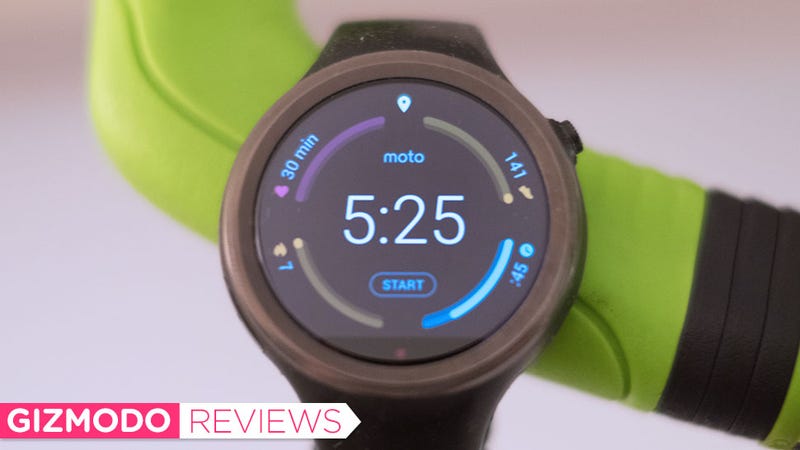
There are smartwatches, and there are fitness trackers. If you want any combination of the two, you’ll have to accept the compromises inherent in cramming a lot of sensors into an attractive, wrist-sized package. This is the problem the Moto 360 Sport comes tantalisingly close to solving.
The Moto 360 Sport is a cousin of the 2015 Moto 360 smartwatch, but with some subtle modifications to make it better for people who like to sweat. Specifically it features a waterproof body, non-interchangeable rubber strap, GPS, and a more accurate barometric altimeter, to measure exactly how many mountains you haven’t climbed. Add that to the 42mm circular screen, heart rate sensor, and Android Wear OS that come standard with any Moto 360, and it’s an impressive smartwatch/fitness tracker package.
As a day-to-day watch, the Sport feels more like a regular 360 (read the review) in a less glamorous package. Notifications still pop up, Google Maps is as good a navigational companion as ever, and the always-on OK Google Now actually works as a party trick.
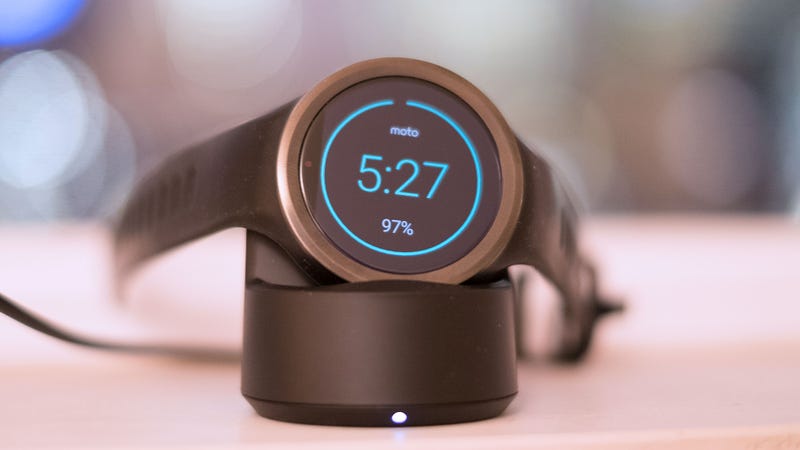
The Sport’s design is also definitely, uh, sporty, but not in a way that screams of your outdoors prowess to anyone who comes within six feet of your wrist. Most outdoors-oriented watches perform badly here, with their huge, clunky screens and giant stamped buttons that reinforce how rugged you are.
The Sport doesn’t do any of that—sure, the black rubber band is nothing to write home about, but at least it’s passable as a day-to-day watch. I actually prefer wearing it over most other smartwatches. It’s comfortable, and the low-profile band doesn’t interfere when your wrists are resting on a laptop. The only downside is the rubber itself, which has a knack for picking up tiny pieces of lint. And the Sport is a one-band-fits-all deal too. That’s unlike the regular 360, where you can change out the bands pretty easily.
The most important design feature is one you can’t see: the Sport is waterproof, and not just in a feel-free-to-wear-it-doing-the-dishes way. It comes with an IP67 waterproof rating, which is good for a half-hour of submersion in a meter of water. I’ve worn it through countless showers, in swimming pools, and even on a brief trip into a frozen lake. There’s never been a problem. Which is more than can be said for the merely water resistant Apple Watch.
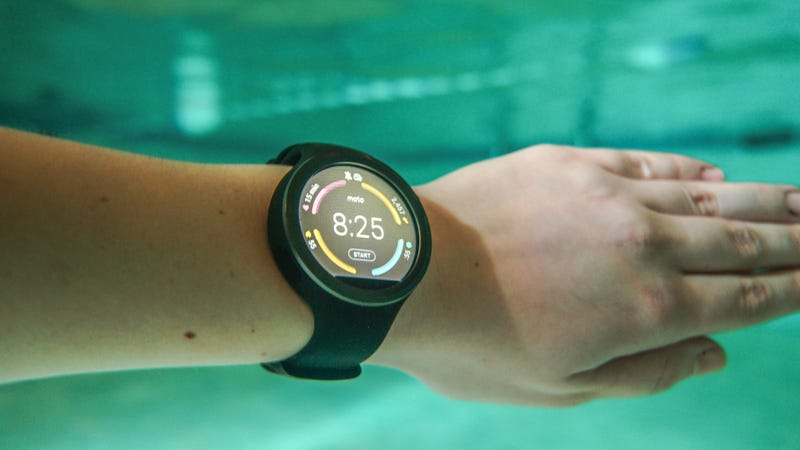
While we’re talking about must-haves for a fitness device: a standalone GPS chip is absolutely killer. Most regular smartwatches omit it because of the cost and battery drain (the Moto 360 Sport beats this by only activating GPS on runs), but GPS in the watch means I can go exercise, not take my phone, and still have a detailed breakdown of how far and fast I went.
Unfortunately, in practice the GPS in the Moto 360 Sport doesn’t seem to match that in my normal running watch, a Garmin Fenix 3. The Sport takes longer to get a satellite lock, and the distance at the end of a known 10K run was off by a couple hundred meters. Not a big deal, but worth bearing in mind if you’re on a hardcore training program.
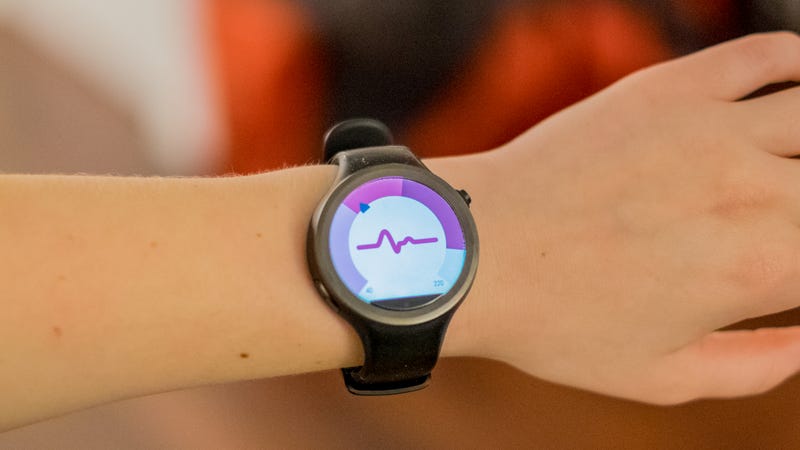
The Sport is crammed full of other sensors, but the only other one that really matters for fitness data is the heart-rate sensor. It’s an optical one, which reads your pulse from veins in the back of your wrist. That’s different from a traditional heart-rate strap, because you don’t have to wear a band around your chest. But optical heart-rate sensors have a higher margin of error than chest straps, and the Sport is particularly bad. I compared it to another optical heart-rate sensor (a Microsoft Band 2), my trusty Garmin’s chest strap, and a medical-style pulse oximeter, all at different levels of exertion.
At lower heart rates, the Sport was off by around 15 percent; when I got my heart up to 160 bpm, it reported anything between 130 and 190, in back-to-back readings. By comparison, the similar sensor on the Band 2 was consistently within 10 percent of my actual heart rate, as measured with the pulse oximeter.
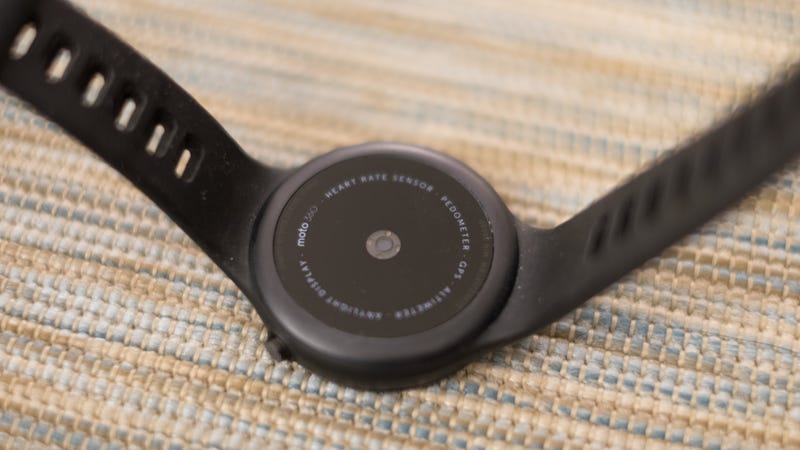
If you’re trying to use the Sport as a training tool, rather than just tracking your heart rate out of casual interest, that variation is a big deal. Sure, it can sense whether you’re walking around or running, but if you’re trying to stay in a particular heart-rate zone, the Sport is probably worse than just guessing.
There’s no redemption in the software, either. General smartwatch interactions are wonderfully easy, as is starting a run—but that’s the only exercise you can actually do. Serious fitness trackers from Garmin and Fitbit give you the option of mountain climbing, brisk walk, or everything in between; Motorola assumes that you only go for runs. Sure, that might be my main activity, but occasionally I get on a bike too, and the idea of a smartwatch fitness tracker is that you can take it everywhere and use it for everything.

But the worst feature is the analytics. The custom Sport watchface that Motorola made for the watch does a fantastic job of displaying steps, activities, and calories at a glance, but if you want to dig any deeper, you can’t. You get a good summary of a run when you complete it, but write it down immediately. You won’t find any charts, graphs, stats, or even any good way of seeing your exercise from the last month. That ultimately pidgeonholes the 360 Sport.
If you go for the occasional run, or you’d like a sturdy smartwatch that nudges you into a little more daily exercise, the Moto 360 Sport does a fantastic job. It manages to be a (semi) useful fitness tracker, and does it while still being a damn good, honest-to-God-smartwatch, but if you’re a serious athlete with a serious training plan, the Sport can’t (quite) replace a dedicated fitness watch—the heart-rate problem and poor software are massive deal-breakers. The Sport 360 does a decent job for being the mutant offspring of a smartwatch and a fitness watch, but “decent” sure as hell isn’t worth the Sport 360’s $299 price.
README
- A fitness watch that’s more than just splashproof
- Optical heart-rate monitor is convenient, but wildly inaccurate
- You should love the wristband, because you can’t exchange it
- Wretched fitness software leaves it behind Garmin, Fitbit, and even the Apple Watch
- Integrated GPS makes for a good running companion



